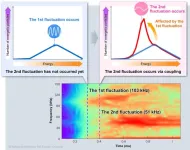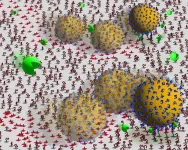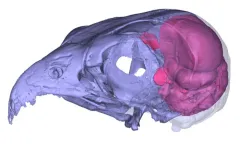(Press-News.org) Background
In nature, phenomena in which multiple fluctuations occur in a coupled manner are frequently observed. For example, in large earthquakes, cases of them occurring consecutively in adjacent regions have been reported. When multiple fluctuations occur in this coupled way, compared to a single fluctuation, the coupled ones release more energy, leading to larger-scale phenomena. In fusion plasmas, fluctuations caused by energetic particles exist and are known to degrade the confinement of energetic particles. On the other hand, these fluctuations are expected to play a role in transferring the energy of the energetic particles to fusion fuel ions for heating. Thus, fluctuations caused by energetic particles are an important issue in fusion research, and among them, fluctuations that occur in a coupled manner are particularly noteworthy because they can develop into large-scale phenomena.
At the ASDEX Upgrade device in Germany, two fluctuations occurring in a coupled manner were observed. Although these fluctuations were attributed to energetic particles, the underlying mechanism of their coupling remained unclear.
Results
Researchers from the National Institute for Fusion Science (NIFS) and the Max Planck Institute for Plasma Physics (IPP) have collaborated on a simulation study to clarify the physical mechanism by which two fluctuations occur in a coupled manner.
NIFS has developed a code named "MEGA" to simulate plasma fluctuations caused by energetic particles. This is called a "hybrid simulation"*3 because it performs coupled and simultaneous calculations for particles and fluid. The MEGA code has been applied to experimental devices in Japan and overseas, with its effectiveness demonstrated through comparisons with various experimental results. This time, Assistant Professor Hao Wang of NIFS and others conducted a simulation using MEGA on a supercomputer and succeeded in reproducing the phenomenon observed in the ASDEX-Upgrade device, in which two fluctuations occur in a coupled manner. In the simulation, the first fluctuation with a frequency of 103 kHz was initially caused by energetic particles, followed by the generation of a second fluctuation with a frequency of 51 kHz, which developed into a larger amplitude than the first (see figure). This simulation result is consistent with the experimental results.
To understand the generation mechanism of the second fluctuation, researchers investigated the time evolution of the distribution function of energetic particles. This describes how many particles with what velocities and energies exist at each location in the plasma. The shape of this distribution function can strongly influence the development of fluctuations and conversely, fluctuations can deform the distribution function. Assistant Professor Hao Wang and his collaborators performed a detailed analysis of the simulation results. They found that as the first fluctuation grew, the distribution function of energetic particles was significantly deformed, and this deformation caused the second fluctuation to occur (see figure). In other words, they revealed that the two fluctuations occurred in a coupled manner via the deformation of the energetic particle distribution function.
Significance and future work
Achieving fusion energy requires energetic particles generated by fusion reactions to heat plasma and sustain these reactions. For this purpose, it is crucial to efficiently confine these energetic particles within the plasma. Coupled fluctuations can lead to significant losses of energetic particles. By utilizing the knowledge of the physical mechanism clarified in this study, it will be possible to contribute to the development of methods to suppress the coupled generation of fluctuations. Furthermore, this physical mechanism may allow us to generate the second fluctuation — which is difficult to excite directly — from the first. This could contribute to heating fuel ions. Moreover, even in space plasmas, although the types of waves differ, coupled fluctuations caused by energetic particles have been observed. The analysis method of the energetic particle distribution function developed in this study is also expected to be applicable to space plasmas.
In the future, we plan to conduct simulations that calculate both energetic particles and fuel ions to investigate the role of the latter and the energy transfer to them in coupled energetic particle driven fluctuations.
Glossary
*1 ASDEX-Upgrade
The ASDEX-Upgrade is a magnetic confinement fusion facility based on the tokamak concept operated by the Max-Planck-Institute for plasma physics in Garching, Germany. The full name of ASDEX is “Axially Symmetric Divertor EXperiment”. The ASDEX-Upgrade has a major radius of 1.65 meters, a plasma volume of 13 cubic meters, and a plasma current of 1.4 megaamperes.
*2 Distribution Function
In simplified models, statistical quantities such as averages are commonly used to describe key parameters. However, a distribution function provides more detailed information about variations within the data. For example, two cups of coffee may have the same average concentration of coffee grounds, but the distribution of those grounds within each cup can differ. In one cup, the grounds might be concentrated at the bottom, resulting in a weaker taste at the top; in the other, the grounds might be more evenly distributed, resulting in a consistent taste throughout. This difference in the distribution of coffee grounds, and consequently in taste, can be effectively described by a distribution function. Just as different distribution functions within coffee cups lead to different tastes and flavors due to variations in concentration, those of particles in a plasma can lead to different physical phenomena by affecting factors such as energy transfer and interparticle interactions.
*3 Hybrid Simulation
Computational models (equations) describing plasma behavior vary depending on the time and spatial scales of interest. A magnetohydrodynamic (MHD) model treats the plasma as a whole, calculating the time evolution of plasma density, fluid velocity, pressure, and electromagnetic fields. Conversely, a particle model calculates the equations of motion for individual particles constituting the plasma. At the National Institute for Fusion Science (NIFS), a hybrid simulation code has been developed. This code uses the MHD model for background plasma and the particle model for energetic and bulk ions, tracking their evolution over time and coupling the two models in a physically consistent manner.
Acknowledgements
This work was partially supported by MEXT as a “Program for Promoting Research on the Supercomputer Fugaku (Exploration of burning plasma confinement physics, JPMXP1020200103)”, JSPS KAKENHI Grant Nos. JP18K13529, JP18H01202, JP21H04973, and “PLADyS”, JSPS Core-to-Core Program, A. Advanced Research Networks. Also, this work was partially supported by the National Institutes of Natural Sciences program of Promoting Research by Networking among Institutions (Grant Number 01422301) and by the International Research Exchange Support Program of NINS. In addition, this work was partially carried out within the framework of the EUROfusion Consortium, funded by the European Union via the Euratom Research and Training Programme (Grant Agreement No. 101052200 - EUROfusion).
Numerical computations were performed on the “Plasma Simulator” (NEC SX-Aurora TSUBASA) of the National Institute for Fusion Science (NIFS) with the support and under the auspices of the NIFS Collaboration Research program (NIFS19KNXN397, NIFS20KNST156, NIFS21KNST196, and NIFS22KIST025), the JFRS-1 supercomputer system at the Computational Simulation Centre of International Fusion Energy Research Centre (IFERC-CSC), and the Supercomputer Fugaku provided by the RIKEN Center for Computational Science (Project IDs: hp200127, hp210178, hp220165).
END
Clarifying the mechanism of coupled plasma fluctuations using simulations
2025-01-22
ELSE PRESS RELEASES FROM THIS DATE:
Here’s what’s causing the Great Salt Lake to shrink, according to PSU study
2025-01-22
The Great Salt Lake, the largest saltwater lake in the Western Hemisphere, reached historic low levels in 2022, raising economic, ecological and public health concerns for Utah. New research from Portland State is believed to be the first peer-reviewed study that quantifies the contributing factors to the record low water volume levels, which the researchers say is important for anticipating and managing future lake changes.
“The lake has a lot of social and economic relevance for the region and Utah,” said Siiri Bigalke, the lead author and a Ph.D. candidate in PSU’s Earth, ...
Can DNA-nanoparticle motors get up to speed with motor proteins?
2025-01-22
DNA-nanoparticle motors are exactly as they sound: tiny artificial motors that use the structures of DNA and RNA to propel motion by enzymatic RNA degradation. Essentially, chemical energy is converted into mechanical motion by biasing the Brownian motion. The DNA-nanoparticle motor uses the "burnt-bridge" Brownian ratchet mechanism. In this type of movement, the motor is being propelled by the degradation (or "burning") of the bonds (or "bridges") it crosses along the substrate, essentially biasing its motion forward.
These nano-sized motors are highly programmable and can be ...
Childhood poverty and/or parental mental illness may double teens’ risk of violence and police contact
2025-01-22
Living with persistent poverty and/or parental mental illness throughout childhood may double the risk of carrying and/or using a weapon and getting on the wrong side of the law by the age of 17, suggests research published online in the Journal of Epidemiology & Community Health.
These factors may account for nearly 1 in 3 cases of weapon use or carriage and more than a quarter of all police contact among 17 year olds, nationwide, estimate the researchers.
Youth crime and violence are common around the world, they note. In England and Wales, for example, around 104,400 first-time offenders were ...
Fizzy water might aid weight loss by boosting glucose uptake and metabolism
2025-01-22
Fizzy water might aid weight loss by boosting blood glucose uptake and metabolism—the rate at which the body uses and converts energy—but the effects are so small, drinking it can’t be relied on alone to shed the pounds, concludes a brief analysis published in the open access journal BMJ Nutrition Prevention & Health.
There are no quick fixes to slimming down and keeping off the weight, says the author: regular physical activity and a healthy balanced diet are still essential, added to which the long term effects of drinking large amounts of carbonated water aren’t known.
Because ...
Muscular strength and good physical fitness linked to lower risk of death in people with cancer
2025-01-22
Muscular strength and good physical fitness are linked to a significantly lower risk of death from any cause in people with cancer, finds a pooled data analysis of the available evidence, published online in the British Journal of Sports Medicine.
Tailored exercise to boost muscle strength and cardiorespiratory fitness in patients with cancer may help boost their chances of survival, suggest the researchers.
In 2022 alone, 20 million people were diagnosed with cancer worldwide, and nearly ...
Recommendations for studying the impact of AI on young people's mental health proposed by Oxford researchers
2025-01-22
A new peer-reviewed paper from experts at the Oxford Internet Institute, University of Oxford, highlights the need for a clear framework when it comes to AI research, given the rapid adoption of artificial intelligence by children and adolescents using digital devices to access the internet and social media.
Its recommendations are based on a critical appraisal of current shortcomings in the research on how digital technologies’ impact young people’s mental health, and an in-depth analysis of the challenges underlying those shortcomings.
The paper, “From ...
Trump clusters: How an English lit graduate used AI to make sense of Twitter bios
2025-01-22
An English literature graduate turned data scientist has developed a new method for large language models (LLMs) used by AI chatbots to understand and analyse small chunks of text, such as those on social media profiles, in customer responses online or for understanding online posts responding to disaster events.
In today’s digital world, such use of short text has become central to online communication. However, analysing these snippets is challenging because they often lack shared words or context. This lack of context makes it difficult for AI to find patterns ...
Empty headed? Largest study of its kind proves ‘bird brain’ is a misnomer
2025-01-22
It’s difficult to know what birds ‘think’ when they fly, but scientists in Australia and Canada are getting some remarkable new insights by looking inside birds' heads.
Evolutional biologists at Flinders University in South Australia and neuroscience researchers at the University of Lethbridge in Canada have teamed up to explore a new approach to recreating the brain structure of extinct and living birds by making digital ‘endocasts’ from the area inside a bird skeleton’s empty cranial space.
Published today in Biology Letters, the study led by the ‘Bones and Diversity Lab’ at Flinders and the Iwaniuk Lab at the University ...
Wild baboons not capable of visual self-awareness when viewing their own reflection
2025-01-22
Published today in Proceedings of the Royal Society B, the study found that while the baboons noticed and responded to a laser mark shone on their arms, legs and hands, they did not react when they saw, via their mirror reflection, the laser on their faces and ears.
It was the first time a controlled laser mark test has been done on these animals in a wild setting and strengthens the evidence from other studies that monkeys don’t recognise their own reflection.
The researchers observed 120 Chacma ...
$14 million supports work to diversify human genome research
2025-01-21
Washington University School of Medicine in St. Louis has received two large grants renewing funding for the Human Pangenome Reference Sequencing Project. This ambitious program began in 2019 with the goal of increasing the diversity of human genome sequences that are pooled into the widely used reference genome. A thorough representation of human genetic diversity can help researchers discover how genetic variation contributes to disease and perhaps offer new routes to innovative treatments.
Funded by the National Human Genome Research Institute ...



